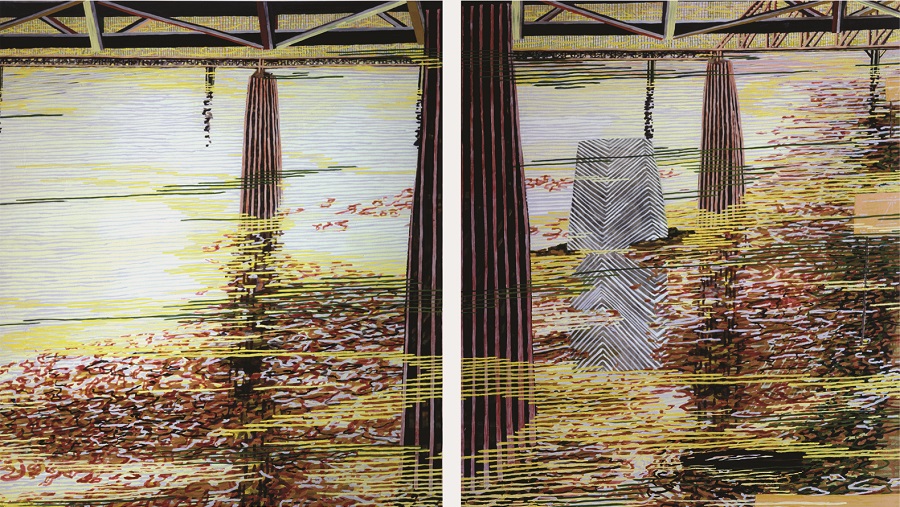Employing a favoured strategy of mutable vantage points, in the aptly–titled Change (2005) Chaseling propels the viewer through an almost dizzying succession of perspectives.
Claudia Chaseling
Born 1973, Munich, Germany
At first glance the urban landscape paintings of Claudia Chaseling suggest aspects of Australian modernism of the 1930s, yet the reality is rather different, for her work denotes an intriguing hybridity of influences. In 1999 as part of an Australian National University exchange program, the German-born and educated Chaseling – now resident in Australia – visited indigenous communities in the Northern Territory and Western Australia before returning temporarily to Berlin in 2000.
The lyricism of the four–panelled work Losing Perspective (2004) clearly quotes from the Romanticism of Caspar David Friedrich, but an intriguing point of difference is Chaseling's trademark deployment of a fine all–over tracery of cross–hatching – a technique more customarily associated with Australian indigenous artists. Although her palette is consistently vivid and the pigments unmixed, in the darker, moodier six–panelled Motion (2005) the forms have become almost abstracted and in two upper panels a darkly–ominous aeroplane looms, casting its shadow over the composition. Employing a favoured strategy of mutable vantage points, in the aptly–titled Change (2005) Chaseling propels the viewer through an almost dizzying succession of perspectives. It is a sensation encapsulated in the deft interweaving of line and colour that generates a rhythmical meshing of arcs and loops in the closely–cropped roller–coaster of Speed (2005).
Making numerous preparatory drawings/watercolours, Chaseling's process is extremely labour intensive, involving not only the meticulous application of multiple layers of pigment, but also the incorporation of multiple (layered) images within the same work. Eschewing the flatness of gridwork that is Modernism's legacy, the perception – conveyed through permeable grids that expand rather than constrain – is paradoxically one of lightness and depth. Frequently a final transparent film of red paint is applied to the finished canvas, in order to make the work 'come alive.' In such a way, Chaseling merges an investigation of the history and potentialities of her medium with a contemporary preoccupation with memory, transience, change, movement.
Rather than a contemporary realisation of the Romantic sublime, Chaseling's carefully realised vignettes – layered, sequential, blurred, fragmentary – are an analogue for the subjective, imperfect nature of human recall and for multi–faceted ways of viewing.
Wendy Walker from her Samstag catalogue essay, The memorable: ephemeral
2006 Anne & Gordon Samstag International Visual Arts Scholarship
2006 Graduate Diploma in Fine Art, Central St Martins College, London, UK
2003 Master of Visual Arts, Australian National University, Canberra
2000 Master of Visual Arts, University for Visual Arts Berlin, Germany
1999 Exchange student, masters program, Australian National University, Canberra,
1993 Academy for Visual Arts, Munich, Germany Summer Academy Salzburg, Austria, Prof. Herman Nitsch Academy for Visual Arts, Vienna, Austria, Prof. Lehmden
Artist's website
www.claudiachaseling.com

